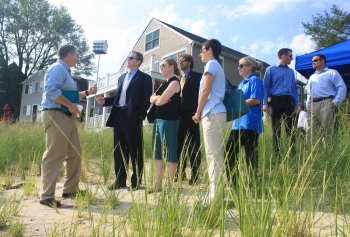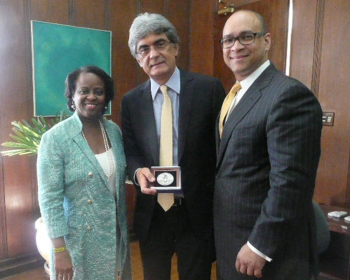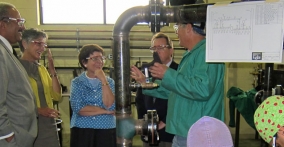This
morning, Acting Secretary Rebecca Blank joined U.S. Representatives Chaka Fattah and Allyson
Schwartz on a tour of the job training facilities of Steamfitters Local 420 in
Philadelphia, where classes are held for
apprentices and journeyworkers to develop and improve their skills so they can
better serve clients and become qualified for a broader range of employment
opportunities.
The
rigorous training and education being offered at the facility has made a
difference in the lives of hundreds of people throughout the region. The
steamfitters local union 420 training center services the entire state and the
work being done by members helps keep the region's infrastructure running
smoothly, helping to make southeastern Pennsylvania an attractive place to do
business.
Today's visit was an opportunity for local business leaders,
workers and entrepreneurs to showcase all that they are doing to support
manufacturing, train a 21st century workforce, and help the American economy
recover from the worst recession since the Great Depression.
While there is still more work
to be done, our private sector has now had 29 straight months of job growth,
creating 4.5 million new jobs. Over the past two and one-half years, more than a half-million manufacturing jobs have been created in the U.S.— the strongest
job growth in that sector since the 1990s.
Pennsylvania
alone has gained over 10,000 new manufacturing jobs since January, 2010.
And these manufacturing jobs are good jobs that pay more than average and
provide greater benefits.
During
the visit, Acting Secretary Blank affirmed Commerce’s efforts to build a strong
environment for manufacturing and innovation in the U.S. For example, the
Obama administration recently announced the launch of a new public-private
institute for manufacturing innovation as part of its ongoing efforts to help
revitalize American manufacturing and encourage companies to invest in the
United States. This new partnership, the National Additive Manufacturing
Innovation Institute (NAMII), includes manufacturing firms, universities, community
colleges, and non-profit organizations from the Ohio-Pennsylvania-West Virginia "Tech Belt."
Though
progress has been made, more work remains. This is why the Obama administration continues to call on Congress to pass legislation to give our
companies a tax break if they move operations and jobs back. President
Obama has also called for helping state and local governments hire or retain teachers,
police, and firefighters; and putting construction workers by to work while
repairing crumbling American infrastructure. These proposals would create
a million new jobs, according to independent economists.
After
visiting the steamfitters' training facilities, Acting Secretary Blank traveled
to Allentown, Pennsylvania, to announce
a grant to help local small manufacturers lower operating costs and create
jobs. She was joined by Allentown Mayor Ed Pawlowski, local business leaders,
and entrepreneurs to highlight Obama administration efforts to help local
companies and workers build things here so they can sell them everywhere.











